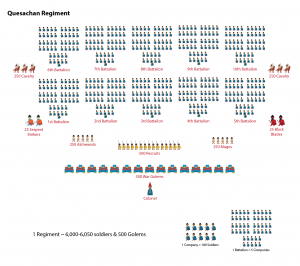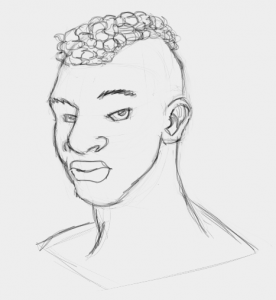December 19, 2015
Quesachan Army
Here’s a fun post for the lore oriented geeks like me! Today I’m going to go over the basics of the structure and rankings of the Quesachan military. With pictures! Lots and lots of pictures. It’s not something you need to know to play Waracle, but it’s great for background lore, particularly if you plan on making a Quesachi!
So without further ado, here’s a rundown on the world’s largest military!
Organization
Every great empire has a strong military force, and a great military force depends on clear organization and logistics to run smoothly. Also known as Tonacayo – the Body of the Empire, the Quesachan army is the blade that enforces Imperial law and expansion. Approximately 605,000 soldiers (excluding officers and specialists) make up the bulk of the army’s forces. This massive manpower is supplemented by a force of 50,000 war golems. How do the Quesachi organize such a massive military? With a clear tiered system:
- Divisions: The army is grouped by 5 regional Divisions, also known as Iyollo – the Mind of the Empire. Synonymous with governmental regions, these divisions are: North, East, Central, West, and South. Each Division has about 100,000 soldiers and 10,000 golems. Major Generals are in charge of divisions.
- Regiments: Each division is divided into 20 Regiments, also known as Teyolitia – the Soul of the Empire. Regiments are numbered 1-20 and are grouped by local region. Each regiment has about 5,000 soldiers and 500 golems and will sometimes include cavalry, specialists (alchemists or mages), or master swordsmen depending on need. Colonels command regiments.
- Battalions: Each regiment is divided into 10 Battalions, also known as Huitoni – the Beating Heart of the Empire. Battalions are numbered 1-10 and are organized by seniority, with the 1st Battalion containing the most experienced soldiers in the regiment. Cavalry, specialists, golems and master swordsmen are in their own separate battalions and used when needed. Each battalion includes about 500 soldiers. Captains command battalions.
- Companies: Each battalion is divided into 5 Companies, also known as Ezcocotli – The Veins of the Empire. Companies are typically ranked by seniority. Each company has about 100 soldiers. Commanders are in charge of companies.
- Squads: Each company is divided into 20 soldiers, collectively referred to as Eztli – The Blood of the Empire. During special missions, these soldiers may be divided into squads of about 10 soldiers, led by the most senior soldier in the squad who directly reports to commanders.
The names for each tier of organization are symbolic: The soldiers are the blood that runs through the veins, which power the beating heart. The heart powers the soul which enriches the mind, and the mind powers the body of the empire.
Here’s a chart of the army breakdown, and a diagram of a full regiment:
Click to view full size.
Ranking
There are many ranks within the army; many can be reached through multiple means, and many sub ranks are technically equal, but carry a higher status of honor, such as standard bearers. Quesachi distinguish between ranks by armor and warpaint. Both men and women serve in the military, and there are no differences in their uniforms save one: Some women bind their breasts to keep them out of the way in combat, though this is not a requirement, but a matter of personal preference. Below is a gallery of the ranks and their accompanying uniforms, and here is a chart that shows the flow of ranks. Beside each soldier is an example of the type of shield they use, which is detailed further in the Shields section.
[slideshow_deploy id=’634′]
Hover over each slide to view a description.
There are only two hairstyles used in the military, regardless of gender, social status, or rank. The first is a simple topknot tied at the back of the head, as seen in the uniform images above. An alternative is available to soldiers from the southern empire, who tend to have coarser, kinkier hair that takes great effort to straighten. Instead, these soldiers twist their hair to create tight curls and shave the sides of the head, leaving a curly mohawk:
Click to view full size.
Nobility in the military must keep soldier haircuts while on duty; when off duty or retired, they may use the hairstyle of their respective noble ranking if preferred.
Shields
Shields are vital not only for their protection, but for identification. A shield reveals a soldier’s division, regiment, and battalion. Special units like the Black Blades have their own unique unit shields. With the exception of cavalry (who typically use standards instead of shields to show division and regiment), every soldier has a shield. Quesachan shields are made of wood and covered in dyed hide and feathers to create highly stylized effects. Below are diagrams that show the designs and systems of military shields.
[slideshow_deploy id=’670′]


